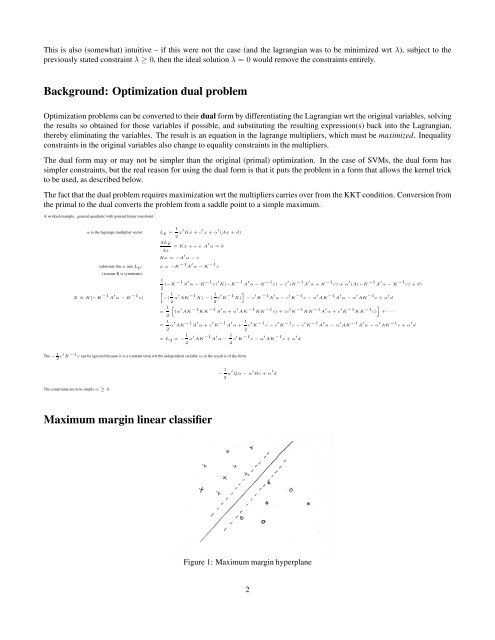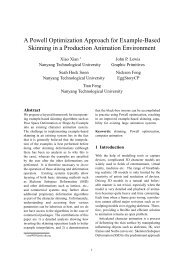A Short SVM (Support Vector Machine) Tutorial ... - JP Lewis
A Short SVM (Support Vector Machine) Tutorial ... - JP Lewis
A Short SVM (Support Vector Machine) Tutorial ... - JP Lewis
You also want an ePaper? Increase the reach of your titles
YUMPU automatically turns print PDFs into web optimized ePapers that Google loves.
This is also (somewhat) intuitive – if this were not the case (and the lagrangian was to be minimized wrt λ), subject to the<br />
previously stated constraint λ ≥ 0, then the ideal solution λ = 0 would remove the constraints entirely.<br />
Background: Optimization dual problem<br />
Optimization problems can be converted to their dual form by differentiating the Lagrangian wrt the original variables, solving<br />
the results so obtained for those variables if possible, and substituting the resulting expression(s) back into the Lagrangian,<br />
thereby eliminating the variables. The result is an equation in the lagrange multipliers, which must be maximized. Inequality<br />
constraints in the original variables also change to equality constraints in the multipliers.<br />
The dual form may or may not be simpler than the original (primal) optimization. In the case of <strong>SVM</strong>s, the dual form has<br />
simpler constraints, but the real reason for using the dual form is that it puts the problem in a form that allows the kernel trick<br />
to be used, as described below.<br />
The fact that the dual problem requires maximization wrt the multipliers carries over from the KKT condition. Conversion from<br />
the primal to the dual converts the problem from a saddle point to a simple maximum.<br />
A worked example, general quadratic with general linear constraint.<br />
α is the lagrange multiplier vector Lp = 1 x ′ Kx + c ′ x + α ′ (Ax + d)<br />
2<br />
dLp<br />
= Kx + c + A ′ α = 0<br />
dx<br />
Kx = −A ′ α − c<br />
substitute this x into Lp:<br />
(assume K is symmetric)<br />
X ≡ K(−K −1 A ′ α − K −1 c)<br />
x = −K −1 A ′ α − K −1 c<br />
1<br />
(−K −1 A ′ α − K −1 c) ′ K(−K −1 A ′ α − K −1 c) − c ′ (K −1 A ′ α + K −1 c) + α ′ (A(−K −1 A ′ α − K −1 c) + d)<br />
2<br />
[<br />
]<br />
−( 1 α ′ AK −1 X) − ( 1 c ′ K −1 X) − c ′ K −1 A ′ α − c ′ K −1 c − α ′ AK −1 A ′ α − α ′ AK −1 c + α ′ d<br />
2<br />
2<br />
[<br />
]<br />
= 1 (α ′ AK −1 KK −1 A ′ α + α ′ AK −1 KK −1 c) + (c ′ K −1 KK −1 A ′ α + c ′ K −1 KK −1 c) + · · ·<br />
2<br />
= 1 α ′ AK −1 A ′ α + c ′ K −1 A ′ α + 1 c ′ K −1 c − c ′ K −1 c − c ′ K −1 A ′ α − α ′ AK −1 A ′ α − α ′ AK −1 c + α ′ d<br />
2<br />
2<br />
= L d = − 1 α ′ AK −1 A ′ α − 1 c ′ K −1 c − α ′ AK −1 c + α ′ d<br />
2<br />
2<br />
The − 1 2 c′ K −1 c can be ignored because it is a constant term wrt the independent variable α so the result is of the form<br />
− 1 2<br />
α ′ Qα − α ′ Rc + α ′ d<br />
The constraints are now simply α ≥ 0.<br />
Maximum margin linear classifier<br />
Figure 1: Maximum margin hyperplane<br />
2







